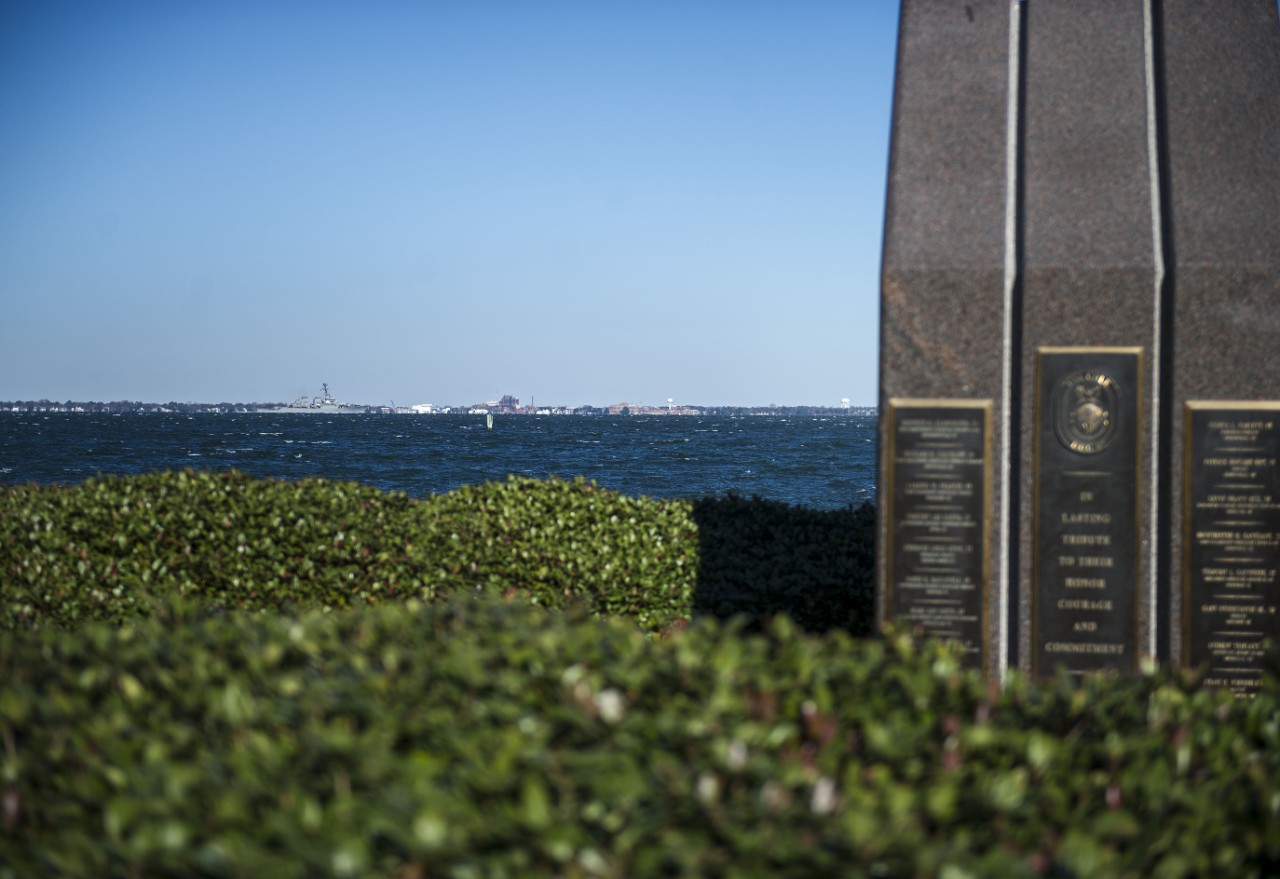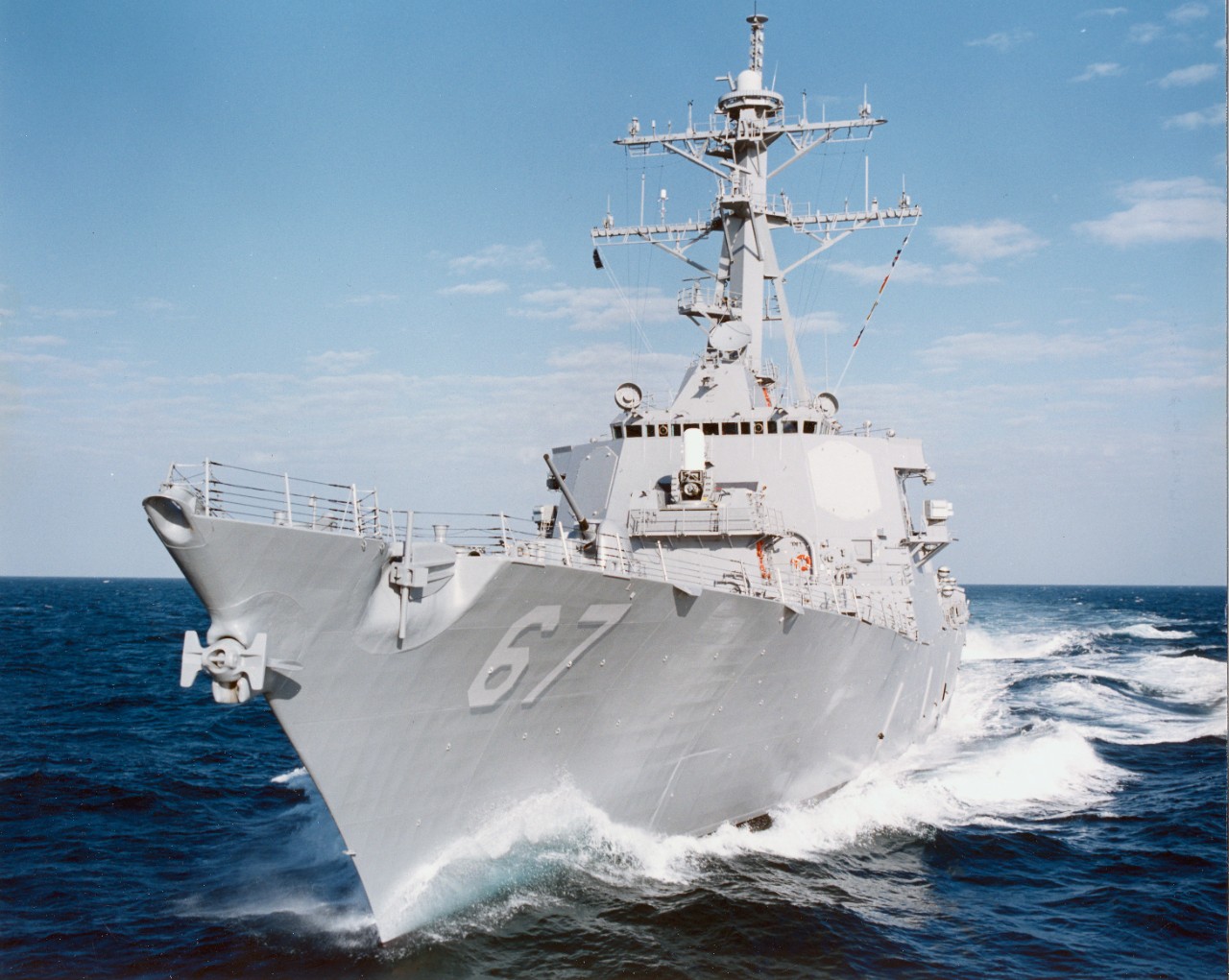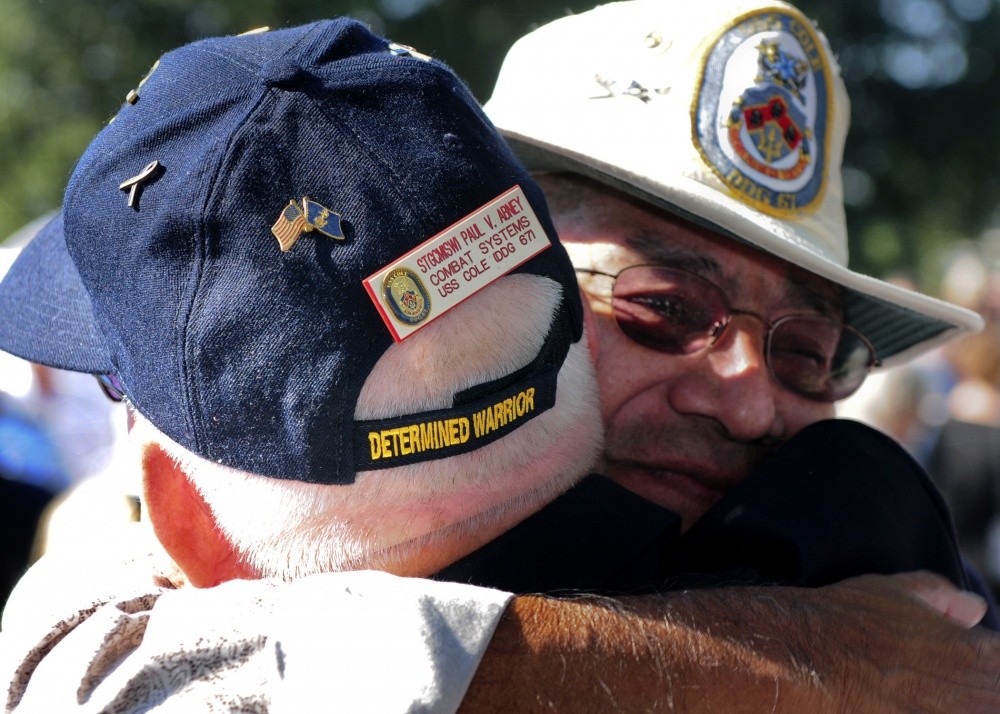H-055-3: Attack on USS Cole (DDG-67) – October 2000

NORFOLK (Dec. 15, 2016) USS Cole (DDG 67), a guided-missile destroyer, passes the USS Cole Memorial as the destroyer departed Naval Station Norfolk for a scheduled deployment to the 5th and 6th fleet areas of responsibility. (U.S. Navy photo by Petty Officer 2nd Class Justin Wolpert/Released)
H-Gram 055, Attachment 3
Samuel J. Cox, Director NHHC
October 2020
H055.3 Attack on USS Cole–October 2000
Sam Cox, Director of Naval History, 08 October 2020
I first wrote this for the 15th anniversary of the attack on USS Cole, but I have added some additional material regarding the threat environment in the U.S. Naval Forces Central Command (NAVCENT) area of responsibility at the time.
Since the dawn of recorded history, city-states and nations that expected to survive would station troops or send patrols to their farthest frontiers to provide early warning of enemy invasion and buy time to mobilize and meet the threat. On 12 October 2000, the guided missile destroyer USS Cole (DDG-67), in a port on the far side of the globe did exactly that. Seventeen Sailors died and 37 were wounded, and the ship was grievously damaged as a result of a determined enemy surprise suicide boat attack in Aden, Yemen.
But in their sacrifice, the crew of Cole gave our nation eleven months of unambiguous warning that we were at war with Osama bin Laden and al-Qaida, or certainly that they were at war with us. Others may debate whether that warning was properly heeded, but that in no way reflects on the valor and sacrifice of the crew who saved their ship from damage that would have sunk any other warship of that size in any other navy in the world, and who brought Cole out of Aden harbor with the massive battle flag of the United States flying high. The crew of Cole who made the ultimate sacrifice must never be forgotten.
Hull Maintenance Technician Second Class Kenneth Eugene Clodfelter, 21, Mechanicsville, Virginia
Chief Electronics Technician Richard Dean Costelow, 35, Morrisville, Pennsylvania
Mess Management Specialist Seaman Lakeina Monique Francis, 19, Woodleaf, North Carolina
Information Systems Technician Seaman Timothy Lee Gauna, 21, Rice, Texas
Signalman Seaman Cherone Louis Gunn, 22, Rex, Georgia
Information Systems Technician Seaman James Rodrick McDaniels, 19, Norfolk, Virginia
Engineman Second Class Marc Ian Nieto, 24, Fond du Lac, Wisconsin
Electronic Warfare Technician Second Class Ronald Scott Owens, 24, Vero Beach, Florida
Seaman Lakiba Nicole Palmer, 22, San Diego, California
Engineman Fireman Joshua Langdon Parlett, 19, Churchville, Maryland
Fireman Patrick Howard Roy, 19, Cornwall-on-Hudson, New York
Electronic Warfare Technician First Class Kevin Shawn Rux, 30, Portland, North Dakota
Mess Management Specialist Third Class Ronchester Mananga Santiago, 22, Kingsville, Texas
Operations Specialist Second Class Timothy Lamont Sanders, 32, Ringgold, Virginia
Fireman Gary Graham Swenchonis Jr., 26, Rockport, Texas
Lieutenant Junior Grade Andrew Triplett, 31, Macon, Mississippi
Seaman Craig Bryan Wibberley, 19, Williamsport, Maryland
On 12 October, it is entirely appropriate to take time to reflect in silence on these lives cut short in the service of our country and the defense of our freedom.
USS Cole (DDG-67) was laid down on 28 February 1994 at Pascagoula, MS, by Ingalls Shipbuilding Division, Litton Industries; launched on 10 January 1995; sponsored by Mrs. Lee Perry, wife of Secretary of Defense William J. Perry; and commissioned on 8 June 1996 at Port Everglades, FL, Commander M. Stewart O'Bryan in command. (L45-54.10.03)
USS Cole was not a random target. Al-Qaida chose to attack a warship flying the flag of the United States precisely because of the symbolism of such an attack. Previously, bin Laden had issued two declarations of war (Fatwas) against the United States (in 1996 and 1998) that, from his perspective, had been ignored. His attacks against the U.S. embassies in Kenya and Tanzania in 1998 resulted in intense criticism of bin Laden, even in extremist circles, due to the extremely high death and injury toll amongst innocent civilians, many of them Muslims. The American response to the embassy bombings came in the form of Tomahawk cruise missile strikes from U.S. Navy ships against al-Qaida training camps in Afghanistan (and a suspected chemical weapons precursor plant in Sudan). The physical damage against the primitive camp infrastructure in Afghanistan was easily repaired. The psychological impact was more profound, as al-Qaida’s leadership understood just how close they came to being hit and killed. Nevertheless, the strike fell well short of bin Laden’s intent for the embassy bombings, which was to provoke such a grossly disproportionate overreaction by the United States that it would galvanize the Muslim world to the final jihad against the U.S. and the infidel world.
Bin Laden chose to attack a warship to demonstrate to the world that he was not afraid of the United States and to provoke the United States by flagrantly attacking a symbol of America’s might and pride. He chose a military target to preclude Muslim casualties. He chose a warship because warships had attacked him, and because he found the presence of American warships in a port in his ancestral homeland of Yemen to be particularly offensive. He chose the method of attack, suicide bombing, to ensure the effectiveness of the attack and to demonstrate to the world the resolve of those committed to his cause, who would go willingly to their deaths to accomplish their mission. By attacking a U.S. Navy warship, bin Laden intended for there to be absolutely no ambiguity that when he “declared war” he meant it.
The first al-Qaida attempt to attack a U.S. warship in Aden, the guided missile destroyer The Sullivans (DDG-68) in January 2000, failed because the attack boat, overloaded with explosives, got stuck in the mud and had to be lifted out of the water by a crane; a highly visible event that Yemeni security services either missed, ignored, or were complicit. The fact is that this failed attack was not known by anyone in the United States until after the attack on Cole. That Aden was a very dangerous place was very well known, as was the entire U.S. Central Command region.
The environment that Cole entered when she transited south through the Suez Canal was fraught with danger. The high-intensity conflict of Desert Storm had been replaced by a lower-intensity combat operation (Southern Watch) in which mobile Iraqi antiaircraft batteries regularly fired on U.S. and Coalition aircraft enforcing the Southern No-fly Zone and were struck by U.S. carrier aircraft in return. U.S. Navy ships had fired Tomahawk cruise missiles into Iraq on short notice in 1993 following the attempted assassination of former President George H. W. Bush in Kuwait, again in 1996 (Operation Desert Strike), and in a major strike campaign along with U.S. carrier aircraft during Operation Desert Fox in December 1998. Tankers smuggling oil out of Iraq in violation of United Nations sanctions frequently played potentially dangerous cat-and-mouse games with U.S. ships enforcing the sanctions, ducking in and out of Iranian territorial waters to thwart pursuit, with the ever-present danger that a smuggling tanker could be used as cover for a terrorist attack, as well as safety hazard to U.S. boarding teams due to the decrepit nature of many of the smuggling ships.
The situation in the Arabian Gulf between Iran and the U.S. was still extremely tense, following the undeclared shooting war of the 1980s during which Stark (FFG-31) was accidentally hit by two Iraqi Exocet missiles, the U.S. captured the IRAN AJR in the act of laying mines in international waters, U.S. Navy ships shelled Iranian oil platforms being used in attacks against neutral shipping, Samuel B. Roberts (FFG-58) survived being deliberately mined by the Iranians, and U.S. Navy forces sank an Iranian frigate and a missile boat and badly damaged a second frigate during Operation Praying Mantis, all culminating in the accidental shoot down of Iranian airliner by the guided-missile cruiser Vincennes (CG-49). By 2000, the Iranians had added a submarine threat capability while Iranian missile boats and Revolutionary Guard speedboats frequently operated within close visual range of U.S. ships, sometimes provocatively, with the ever-present risk of an inadvertent clash.
The CENTCOM region had long been a venue for terrorist attacks against U.S. and Allied interests including the bombing of a U.S. training facility in Riyadh, Saudi Arabia, in 1995, the bombing of the U.S. Air Force housing facility at Khobar Towers, Saudi Arabia, in 1996 and the Nairobi and Dar-es-Salaam embassy bombings in 1998, which led to the U.S. Navy Tomahawk strikes into Afghanistan and Sudan. Al-Qaida was hardly the only terrorist group active in the region; Egyptian Islamic Jihad (which later merged with al-Qaida) was active throughout the region, among many smaller groups, while al-Itihaad al-Islamiya and other Somali terrorist groups were active in the vicinity of Djibouti.
Yemen itself had only emerged from a long and costly civil war, with warring parties still itching to go back at it. It was, at that moment in time, technically the only “democracy” in the region, and as part of U.S. Central Command’s regional engagement strategy, U.S. NAVCENT elements were assisting in clearing left over land-mines in Yemen and responding to CENTCOM and U.S. Ambassador in Yemen’s pressure to make refueling stops in Aden, long a hotbed of lawless activity going back centuries. This, despite the fact that Yemen was a known safe haven for al-Qaida recruitment and logistics operations, with the tacit understanding that the Yemeni government would tolerate such activity so long as al-Qaida conducted no attacks inside Yemen. When al-Qaida “cashed in” their most important logistics hub by attacking Cole, this was a clear indication of major operations to follow in the near term.
In sum, any ship entering the CENTCOM AOR in 2000 was entering a high-threat area with potential danger from many quarters. By 2000, U.S. national intelligence agencies had published a series of warnings, all with a similar theme; al-Qaida operational planning is complete, attacks could occur anywhere in the region (not just Yemen,) at any time, with no additional warning. Although such general warning was useful, and heeded in the form of extensive force protection measures, U.S. forces did not have the option to cower behind sandbags, but had to accomplish their missions. Cole had a mission to ensure that the U.S. had a sufficient number of Tomahawk missiles in range of designated targets at all times. In order to meet the timelines, and because of lack of tankers, Cole had to transit at a speed that required a refueling stop, either in Djibouti, where it was possible to get a truck bomb alongside, or Aden, where the only way to attack a ship was by boat or stand-off weapon. Prior to Cole, twenty-seven U.S. Navy ships conducted brief stops for fuel at Aden without being attacked. In the case of Cole and Aden, al-Qaida demonstrated that they were a determined and resourceful foe, able to take advantage of weakness in U.S. national intelligence as well as operational routine. As a result, al-Qaida achieved tactical surprise.
It is appropriate to remember that just under a year later, 7 October 2001, U.S. Navy ships launched Tomahawk land-attack missiles and strike fighters from the carriers Carl Vinson (CVN-70) and Enterprise (CVN-65) to destroy al-Qaida and Taliban targets in Afghanistan. Shortly joined by carriers Theodore Roosevelt (CV-71) and Kitty Hawk (CV-63), configured to host a joint special operations aviation force, U.S. Navy aircraft flew the great preponderance of tactical strike missions in the initial weeks of the campaign in Afghanistan, hitting targets identified by U.S. special operations teams on the ground embedded with friendly Afghan tribes. U.S. Navy jets proved decisive in blunting determined counter-attacks against friendly Northern Alliance forces in Northern Afghanistan. The Navy’s efforts led to a rapid cascading collapse of Taliban positions. Marines from U.S. Navy amphibious forces, put ashore in southern Afghanistan, ensured that the Taliban could not regroup in their ancestral southern strongholds after being routed from the North.
Carl Vinson was arriving in the U.S. Central Command area of responsibility on 9/11. Enterprise was departing, but reversed course even before being ordered to do so. U.S. Navy surface ships and submarines were already in range of Afghanistan and could have launched Tomahawks immediately, and the carriers could have launched strikes within a couple days. Whether that would have been the right thing to do is debatable given the extensive diplomacy and logistics efforts required to ensure the U.S. Air Force and Special Operations Forces would have the things they needed (over-flight permissions, landing rights, enough tanker assets, combat search and rescue capability, etc.). The point is that U.S. naval forces in the region were ready to attack immediately after 9/11 had they been called upon to do so. And throughout the course of the campaign, every one of those naval forces did their utmost to ensure that the Sailors of USS Cole did not sacrifice in vain.
There are many pejorative words that would accurately describe those who attacked Cole, but “coward” would not be one I would choose to use. The men on the boat that came alongside Cole knowingly and willingly went to their deaths for a cause they believed in. Nor would I describe the Sailors on Cole as “victims.” They were U.S. Navy Sailors doing their duty in one battle in a long war against an enemy of the United States. Those who have read my H-Grams on the Kamikazes at Okinawa will know that even against an overwhelming technologically and numerically superior adversary, an enemy that is determined to die for their cause will get in blows. Cole took such a blow. But I do not ascribe to the view that the attack was “successful.” When the smoke cleared, Cole was still there, afloat, with the American flag still flying. The U.S. Navy continued to operate in the region. Cole would be repaired and returned to the fight, and ultimately Osama bin Laden would be dead under the guns of U.S. Navy Seals. But let us never forget the sacrifice of the crew of USS Cole.
(Of note, I do not discuss in detail intelligence warning (or lack thereof) what force protection measures were implemented (or not) by Cole, nor do I discuss the investigations and attempts to bring perpetrators to justice afterwards, as some material is still classified and the attempt at justice is indeed a sorry saga.)




